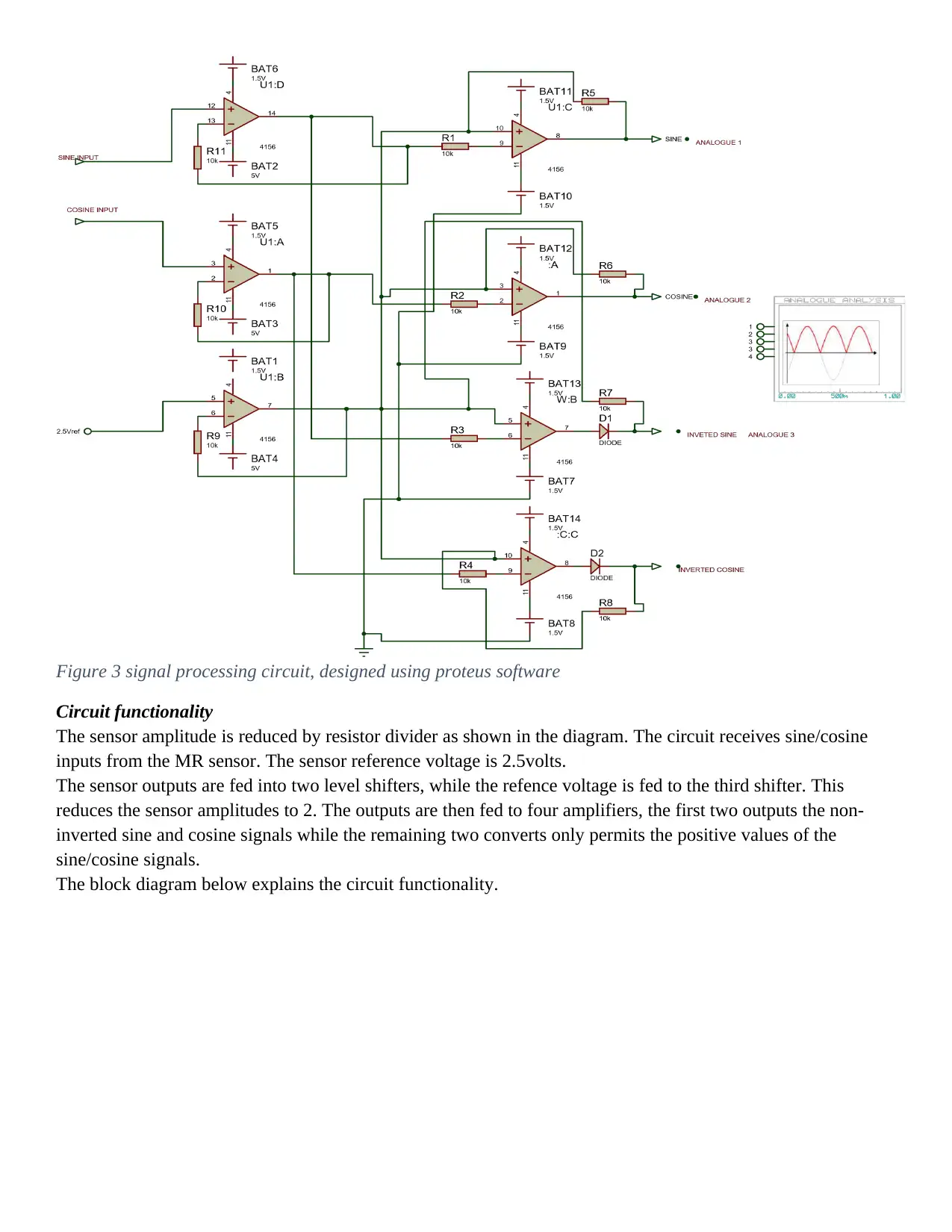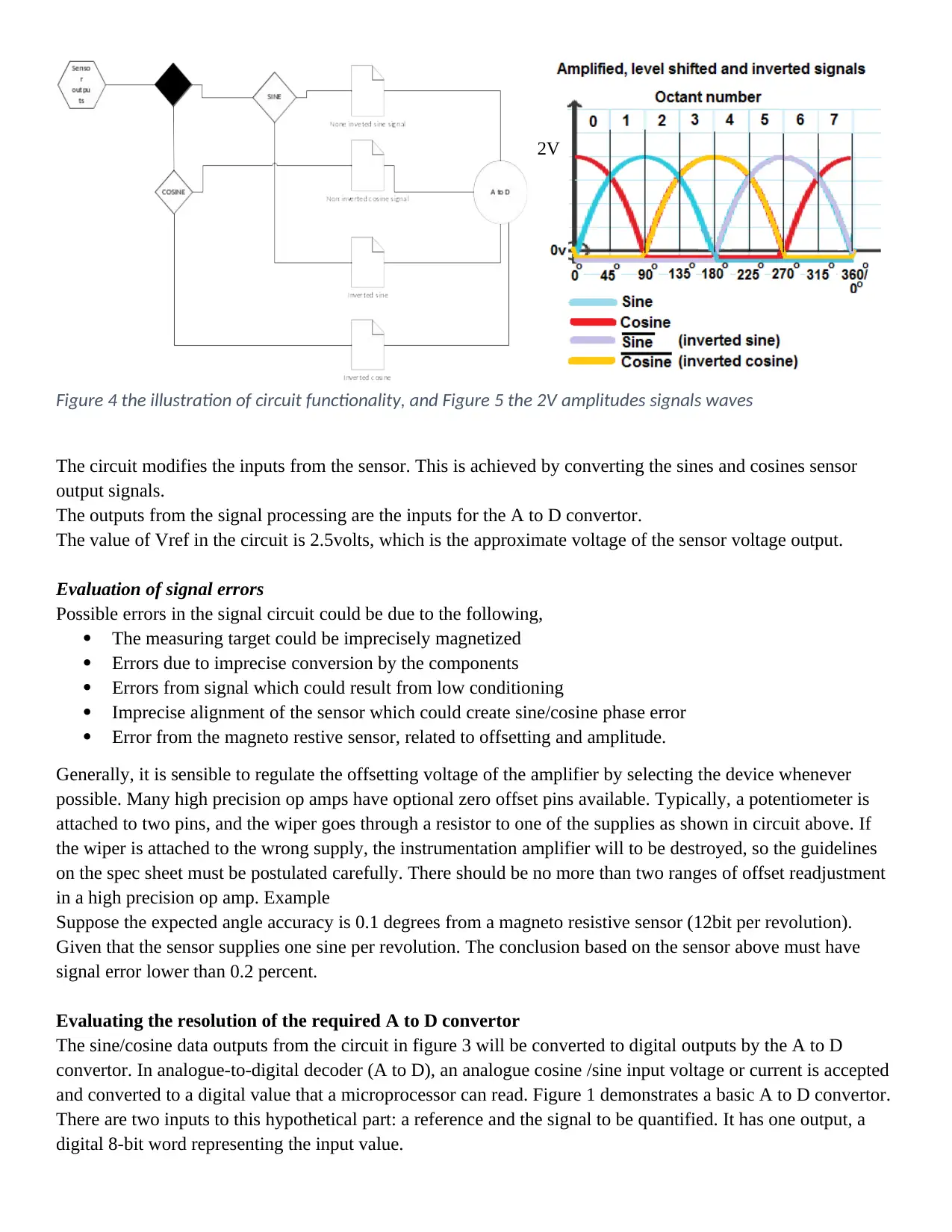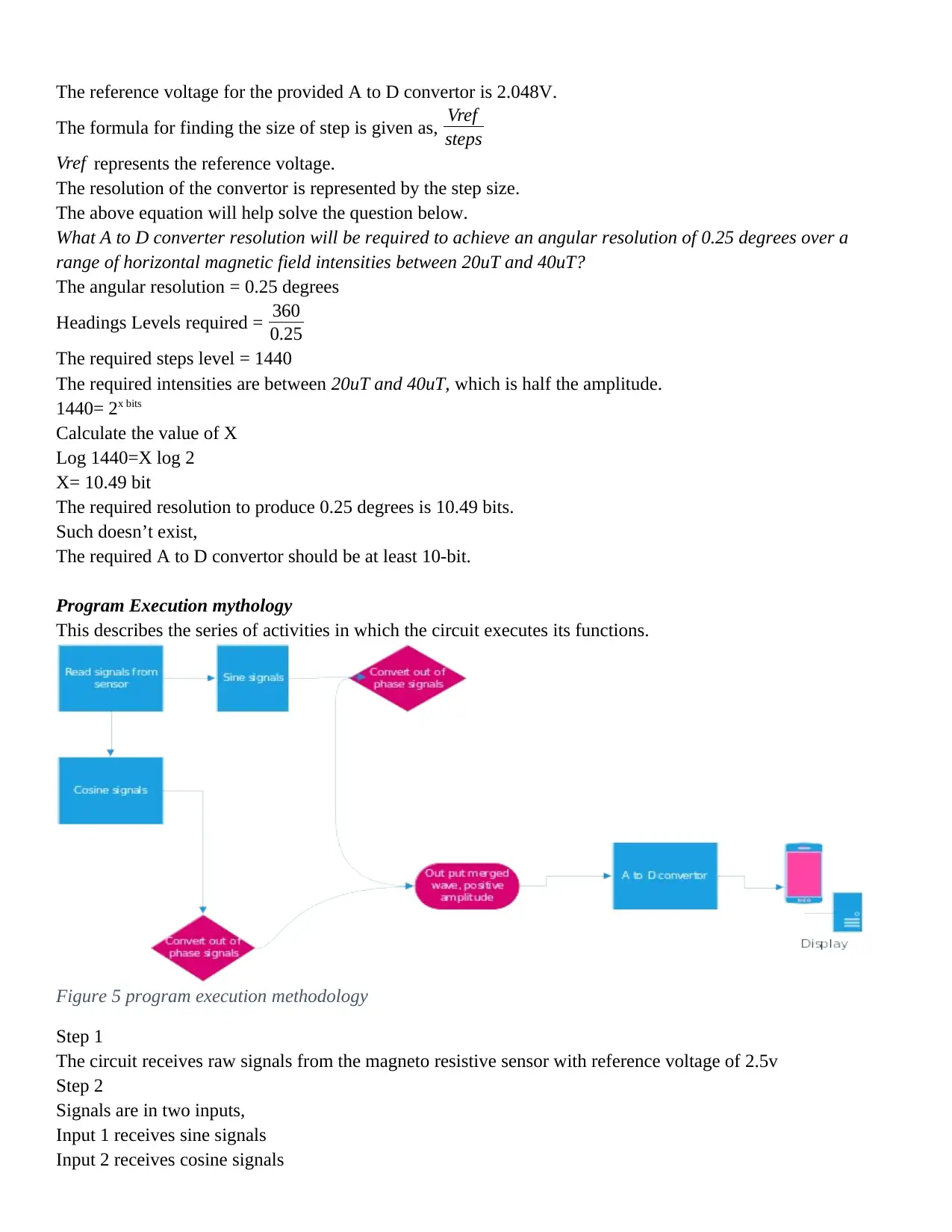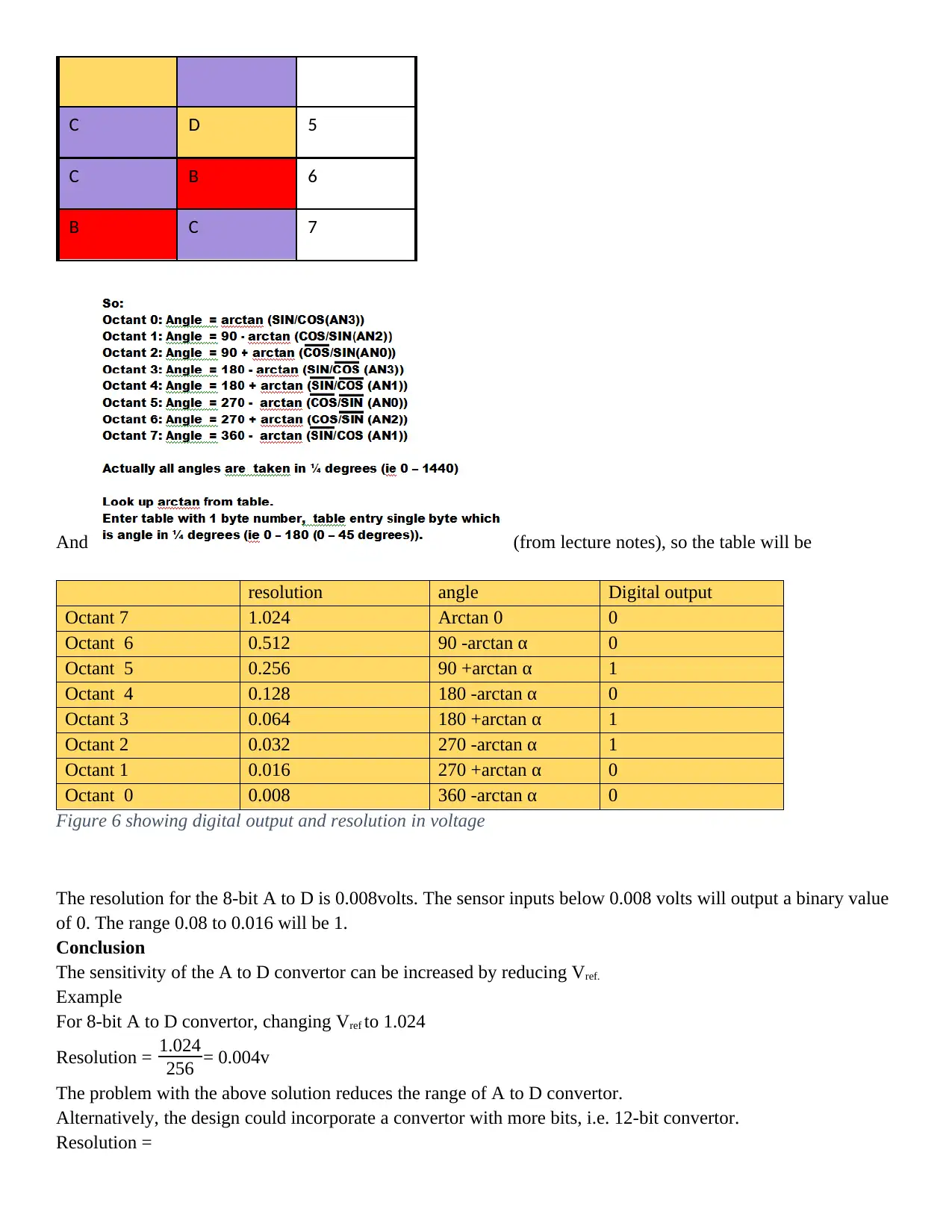Signalling Processing Methodology for Sine/Cosine Sensor: Maximizing Amplitude Output
VerifiedAdded on 2023/04/25
|7
|1521
|199
Summary
AI Summary
In this summary we will discuss about methodology and below are the summaries point:-
The report outlines a signalling processing methodology for a sine/cosine sensor, aiming to maximize amplitude output.
Magnetic sensors provide sine and cosine signals in a 90-degree phase shift, allowing for angle and position determination.
The circuit design involves preconditioning analogue signals and applying variable input amplifiers for noise protection and signal magnification.
Contribute Materials
Your contribution can guide someone’s learning journey. Share your
documents today.

Executive summary
The report presents signalling processing methodology for a sine/cosine sensor. The cosine and sine signals will
be matched to output a maximum amplitude. The sensor outputs of sine and cosine corresponds to the intensity
of the environment intensity. The sensor outputs a reference voltage of relatives 2.5volts, with deviation ranging
of +/- 0.1volts.
Introduction
Magnetic sensors used for positioning and motion sensing usually provide their signals in sine and cosine. The
two output signals are in phase shift of 90 degrees. The 90 degrees phase shift is significant for determining the
angle or position of the input cycle. The direction if the object is moving will also be identified. To achieve high
precision, precise interpolation of the sensor output must be evaluated.
Figure 1 sensor output at 40uT field and Figure 2 sensor output at 20uT field
Methodology
High-accuracy electromagnetic and optical sensors provide the angle or width data encoded in a cosine and sine
signal shifted to 90 degrees. The interpolation is culpable for the non-linear A / D transformation to convert sine
/ cosine signals into angle steps either gradually displayed as a so-called amplitude modulation signal or as an
absolute data word representing the phase angle of the sine signal.
Circuit design
The circuit inputs are from a cosine/sine sensor. The approximate voltage input is 2.5 volts. The expected
voltage range should be 0 volts to 2.048volts. A certain proportion of preconditioning of the analogue signals
must be instituted in order to obtain reliable position and velocity information from the sine wave sensor
signals. The variable SIN and COS pulses from the sinusoidal sensor (typically 1Vpp input signal range) must
be applied to variable input amplifiers as a first step. This guarantees maximum noise protection and can also be
used to properly magnify and level the resulting single-end SIN and COS signals for subsequent input into the
Analog to Digital Converter stage.
The formulae below will be used to calculate the resistor values
Input impedance =10k Gain =R2/R3
The report presents signalling processing methodology for a sine/cosine sensor. The cosine and sine signals will
be matched to output a maximum amplitude. The sensor outputs of sine and cosine corresponds to the intensity
of the environment intensity. The sensor outputs a reference voltage of relatives 2.5volts, with deviation ranging
of +/- 0.1volts.
Introduction
Magnetic sensors used for positioning and motion sensing usually provide their signals in sine and cosine. The
two output signals are in phase shift of 90 degrees. The 90 degrees phase shift is significant for determining the
angle or position of the input cycle. The direction if the object is moving will also be identified. To achieve high
precision, precise interpolation of the sensor output must be evaluated.
Figure 1 sensor output at 40uT field and Figure 2 sensor output at 20uT field
Methodology
High-accuracy electromagnetic and optical sensors provide the angle or width data encoded in a cosine and sine
signal shifted to 90 degrees. The interpolation is culpable for the non-linear A / D transformation to convert sine
/ cosine signals into angle steps either gradually displayed as a so-called amplitude modulation signal or as an
absolute data word representing the phase angle of the sine signal.
Circuit design
The circuit inputs are from a cosine/sine sensor. The approximate voltage input is 2.5 volts. The expected
voltage range should be 0 volts to 2.048volts. A certain proportion of preconditioning of the analogue signals
must be instituted in order to obtain reliable position and velocity information from the sine wave sensor
signals. The variable SIN and COS pulses from the sinusoidal sensor (typically 1Vpp input signal range) must
be applied to variable input amplifiers as a first step. This guarantees maximum noise protection and can also be
used to properly magnify and level the resulting single-end SIN and COS signals for subsequent input into the
Analog to Digital Converter stage.
The formulae below will be used to calculate the resistor values
Input impedance =10k Gain =R2/R3
Secure Best Marks with AI Grader
Need help grading? Try our AI Grader for instant feedback on your assignments.

Figure 3 signal processing circuit, designed using proteus software
Circuit functionality
The sensor amplitude is reduced by resistor divider as shown in the diagram. The circuit receives sine/cosine
inputs from the MR sensor. The sensor reference voltage is 2.5volts.
The sensor outputs are fed into two level shifters, while the refence voltage is fed to the third shifter. This
reduces the sensor amplitudes to 2. The outputs are then fed to four amplifiers, the first two outputs the non-
inverted sine and cosine signals while the remaining two converts only permits the positive values of the
sine/cosine signals.
The block diagram below explains the circuit functionality.
Circuit functionality
The sensor amplitude is reduced by resistor divider as shown in the diagram. The circuit receives sine/cosine
inputs from the MR sensor. The sensor reference voltage is 2.5volts.
The sensor outputs are fed into two level shifters, while the refence voltage is fed to the third shifter. This
reduces the sensor amplitudes to 2. The outputs are then fed to four amplifiers, the first two outputs the non-
inverted sine and cosine signals while the remaining two converts only permits the positive values of the
sine/cosine signals.
The block diagram below explains the circuit functionality.

Figure 4 the illustration of circuit functionality, and Figure 5 the 2V amplitudes signals waves
The circuit modifies the inputs from the sensor. This is achieved by converting the sines and cosines sensor
output signals.
The outputs from the signal processing are the inputs for the A to D convertor.
The value of Vref in the circuit is 2.5volts, which is the approximate voltage of the sensor voltage output.
Evaluation of signal errors
Possible errors in the signal circuit could be due to the following,
The measuring target could be imprecisely magnetized
Errors due to imprecise conversion by the components
Errors from signal which could result from low conditioning
Imprecise alignment of the sensor which could create sine/cosine phase error
Error from the magneto restive sensor, related to offsetting and amplitude.
Generally, it is sensible to regulate the offsetting voltage of the amplifier by selecting the device whenever
possible. Many high precision op amps have optional zero offset pins available. Typically, a potentiometer is
attached to two pins, and the wiper goes through a resistor to one of the supplies as shown in circuit above. If
the wiper is attached to the wrong supply, the instrumentation amplifier will to be destroyed, so the guidelines
on the spec sheet must be postulated carefully. There should be no more than two ranges of offset readjustment
in a high precision op amp. Example
Suppose the expected angle accuracy is 0.1 degrees from a magneto resistive sensor (12bit per revolution).
Given that the sensor supplies one sine per revolution. The conclusion based on the sensor above must have
signal error lower than 0.2 percent.
Evaluating the resolution of the required A to D convertor
The sine/cosine data outputs from the circuit in figure 3 will be converted to digital outputs by the A to D
convertor. In analogue-to-digital decoder (A to D), an analogue cosine /sine input voltage or current is accepted
and converted to a digital value that a microprocessor can read. Figure 1 demonstrates a basic A to D convertor.
There are two inputs to this hypothetical part: a reference and the signal to be quantified. It has one output, a
digital 8-bit word representing the input value.
2V
The circuit modifies the inputs from the sensor. This is achieved by converting the sines and cosines sensor
output signals.
The outputs from the signal processing are the inputs for the A to D convertor.
The value of Vref in the circuit is 2.5volts, which is the approximate voltage of the sensor voltage output.
Evaluation of signal errors
Possible errors in the signal circuit could be due to the following,
The measuring target could be imprecisely magnetized
Errors due to imprecise conversion by the components
Errors from signal which could result from low conditioning
Imprecise alignment of the sensor which could create sine/cosine phase error
Error from the magneto restive sensor, related to offsetting and amplitude.
Generally, it is sensible to regulate the offsetting voltage of the amplifier by selecting the device whenever
possible. Many high precision op amps have optional zero offset pins available. Typically, a potentiometer is
attached to two pins, and the wiper goes through a resistor to one of the supplies as shown in circuit above. If
the wiper is attached to the wrong supply, the instrumentation amplifier will to be destroyed, so the guidelines
on the spec sheet must be postulated carefully. There should be no more than two ranges of offset readjustment
in a high precision op amp. Example
Suppose the expected angle accuracy is 0.1 degrees from a magneto resistive sensor (12bit per revolution).
Given that the sensor supplies one sine per revolution. The conclusion based on the sensor above must have
signal error lower than 0.2 percent.
Evaluating the resolution of the required A to D convertor
The sine/cosine data outputs from the circuit in figure 3 will be converted to digital outputs by the A to D
convertor. In analogue-to-digital decoder (A to D), an analogue cosine /sine input voltage or current is accepted
and converted to a digital value that a microprocessor can read. Figure 1 demonstrates a basic A to D convertor.
There are two inputs to this hypothetical part: a reference and the signal to be quantified. It has one output, a
digital 8-bit word representing the input value.
2V

The reference voltage for the provided A to D convertor is 2.048V.
The formula for finding the size of step is given as, Vref
steps
Vref represents the reference voltage.
The resolution of the convertor is represented by the step size.
The above equation will help solve the question below.
What A to D converter resolution will be required to achieve an angular resolution of 0.25 degrees over a
range of horizontal magnetic field intensities between 20uT and 40uT?
The angular resolution = 0.25 degrees
Headings Levels required = 360
0.25
The required steps level = 1440
The required intensities are between 20uT and 40uT, which is half the amplitude.
1440= 2x bits
Calculate the value of X
Log 1440=X log 2
X= 10.49 bit
The required resolution to produce 0.25 degrees is 10.49 bits.
Such doesn’t exist,
The required A to D convertor should be at least 10-bit.
Program Execution mythology
This describes the series of activities in which the circuit executes its functions.
Figure 5 program execution methodology
Step 1
The circuit receives raw signals from the magneto resistive sensor with reference voltage of 2.5v
Step 2
Signals are in two inputs,
Input 1 receives sine signals
Input 2 receives cosine signals
The formula for finding the size of step is given as, Vref
steps
Vref represents the reference voltage.
The resolution of the convertor is represented by the step size.
The above equation will help solve the question below.
What A to D converter resolution will be required to achieve an angular resolution of 0.25 degrees over a
range of horizontal magnetic field intensities between 20uT and 40uT?
The angular resolution = 0.25 degrees
Headings Levels required = 360
0.25
The required steps level = 1440
The required intensities are between 20uT and 40uT, which is half the amplitude.
1440= 2x bits
Calculate the value of X
Log 1440=X log 2
X= 10.49 bit
The required resolution to produce 0.25 degrees is 10.49 bits.
Such doesn’t exist,
The required A to D convertor should be at least 10-bit.
Program Execution mythology
This describes the series of activities in which the circuit executes its functions.
Figure 5 program execution methodology
Step 1
The circuit receives raw signals from the magneto resistive sensor with reference voltage of 2.5v
Step 2
Signals are in two inputs,
Input 1 receives sine signals
Input 2 receives cosine signals
Secure Best Marks with AI Grader
Need help grading? Try our AI Grader for instant feedback on your assignments.

Step 3
The two signals are converted, the diodes eliminate the negative amplitude signals
Step 4
The two signals are merged, and output to A/D convertor. The microcontroller converts to digital as shown in
the next step.
Discussion
It is intended to use integer (rather than floating point) arithmetic operations to process the data from the A to
D converter and calculate the heading.
With the aid of example data describe the arithmetic calculations that will be required. Evaluate the resolution
that will be required at each stage of the calculations.
The questions above will be answered in the discussion below.
Consider the formula
Vref
step ¿ ¿ ¿
Let’s consider an A to D convertor of 8bits.
Therefore,
Step size= 28 =256 steps
Hence
Vref
256
For Vref 2.048V
The important bit in the ADC input defines whether the input voltage is higher than the half of reference.
Given Vref 2.048V
Resolution =
2.048
256 = 0.008volts, this shows the smallest voltage that can be read
Data conversion
From the above calculations,
The data will be converted as shown on table.
Magnitude order of A, B, C & D give octant
Largest 2nd largest Octant
number
B A 0
A B 1
A D 2
D A 3
D C 4
The two signals are converted, the diodes eliminate the negative amplitude signals
Step 4
The two signals are merged, and output to A/D convertor. The microcontroller converts to digital as shown in
the next step.
Discussion
It is intended to use integer (rather than floating point) arithmetic operations to process the data from the A to
D converter and calculate the heading.
With the aid of example data describe the arithmetic calculations that will be required. Evaluate the resolution
that will be required at each stage of the calculations.
The questions above will be answered in the discussion below.
Consider the formula
Vref
step ¿ ¿ ¿
Let’s consider an A to D convertor of 8bits.
Therefore,
Step size= 28 =256 steps
Hence
Vref
256
For Vref 2.048V
The important bit in the ADC input defines whether the input voltage is higher than the half of reference.
Given Vref 2.048V
Resolution =
2.048
256 = 0.008volts, this shows the smallest voltage that can be read
Data conversion
From the above calculations,
The data will be converted as shown on table.
Magnitude order of A, B, C & D give octant
Largest 2nd largest Octant
number
B A 0
A B 1
A D 2
D A 3
D C 4

C D 5
C B 6
B C 7
And (from lecture notes), so the table will be
resolution angle Digital output
Octant 7 1.024 Arctan 0 0
Octant 6 0.512 90 -arctan α 0
Octant 5 0.256 90 +arctan α 1
Octant 4 0.128 180 -arctan α 0
Octant 3 0.064 180 +arctan α 1
Octant 2 0.032 270 -arctan α 1
Octant 1 0.016 270 +arctan α 0
Octant 0 0.008 360 -arctan α 0
Figure 6 showing digital output and resolution in voltage
The resolution for the 8-bit A to D is 0.008volts. The sensor inputs below 0.008 volts will output a binary value
of 0. The range 0.08 to 0.016 will be 1.
Conclusion
The sensitivity of the A to D convertor can be increased by reducing Vref.
Example
For 8-bit A to D convertor, changing Vref to 1.024
Resolution = 1.024
256 = 0.004v
The problem with the above solution reduces the range of A to D convertor.
Alternatively, the design could incorporate a convertor with more bits, i.e. 12-bit convertor.
Resolution =
C B 6
B C 7
And (from lecture notes), so the table will be
resolution angle Digital output
Octant 7 1.024 Arctan 0 0
Octant 6 0.512 90 -arctan α 0
Octant 5 0.256 90 +arctan α 1
Octant 4 0.128 180 -arctan α 0
Octant 3 0.064 180 +arctan α 1
Octant 2 0.032 270 -arctan α 1
Octant 1 0.016 270 +arctan α 0
Octant 0 0.008 360 -arctan α 0
Figure 6 showing digital output and resolution in voltage
The resolution for the 8-bit A to D is 0.008volts. The sensor inputs below 0.008 volts will output a binary value
of 0. The range 0.08 to 0.016 will be 1.
Conclusion
The sensitivity of the A to D convertor can be increased by reducing Vref.
Example
For 8-bit A to D convertor, changing Vref to 1.024
Resolution = 1.024
256 = 0.004v
The problem with the above solution reduces the range of A to D convertor.
Alternatively, the design could incorporate a convertor with more bits, i.e. 12-bit convertor.
Resolution =

2.048
4096 = 0.0005volts
4096 = 0.0005volts
1 out of 7
Your All-in-One AI-Powered Toolkit for Academic Success.
+13062052269
info@desklib.com
Available 24*7 on WhatsApp / Email
![[object Object]](/_next/static/media/star-bottom.7253800d.svg)
Unlock your academic potential
© 2024 | Zucol Services PVT LTD | All rights reserved.

